#namibian giraffe
Text
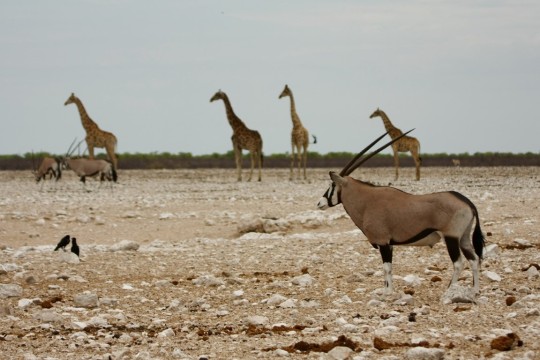
Gemsbok Oryx gazella, front and left back
Namibian giraffe Giraffa giraffa angolensis, back
With Cape crow Corvus capensis, left mid-ground
Observed by markuslilje, CC BY-NC-ND
#multi-ungulate#Oryx gazella#gemsbok#Bovidae#antelope#Giraffa giraffa angolensis#Namibian giraffe#Giraffidae#giraffe#non-ungulate#Corvus capensis#Cape crow#bird#passerine#Africa#Namibia
22 notes
·
View notes
Text

I'm tired of drawing giraffes, but fortunately, I only have one more left to finish. After that, I'm excited to move on to drawing the Okapi, and once the family will be complete. Awesome!
Angolan Giraffe
The Angolan Giraffe, also known as the Namibian Giraffe, is native to southern Africa, specifically Namibia, Zambia, Botswana, Zimbabwe, and Angola. These giraffes have a unique coat pattern with irregular rusty brown patches on a whitish or light beige skin. Males have a distinctive bulk in the forefront.
There have been studies suggesting that the two surviving populations, one in the north and one in the south, may be different subspecies, but this conclusion has not yet been universally accepted within the scientific community. The distinction between giraffe species and subspecies as a whole is not yet fully clear.
_______________________________________
Credits:
Angolan Giraffe
Photo Credits:
Zdeněk Hašek
________________________________________
Thank you for your support. Likes, reblogs, and comments are appreciated. Please consider donating to the project by purchasing a cellphone or laptop wallpaper, here. Your contribution will be greatly appreciated. Cheers!
#namibian giraffe#angolan giraffe#giraffe#jirafa#digital artist#drawing animals#animal drawing#illo#scientific illustration#illustration art#cute animals#love animals#cute animals drawing#wild animal#wild life#wild animals#inforgraphics#science side of tumblr#natural illustration#hyperrealism#realistic
31 notes
·
View notes
Text
Affordable Car Rentals in Namibia: Start Your Adventure with Cheaper Flights & Hotels
Discover Namibia with Cheap Car Rentals
Namibia, known for its stunning landscapes and diverse wildlife, is a dream destination for travelers. From the vast deserts to the breathtaking coastlines, there’s so much to explore. However, to truly experience all that Namibia has to offer, having a reliable mode of transportation is essential. At Cheaper Flights & Hotels, we provide affordable car rental options that allow you to travel around Namibia without breaking the bank. Visit cheaperflightshotels.com to find the perfect vehicle for your adventure.
Why Choose Our Cheap Car Rentals?
Competitive Prices: We offer some of the most competitive car rental rates in Namibia. Whether you're on a tight budget or just looking for the best deal, you'll find it here.
Wide Selection of Vehicles: From compact cars to SUVs, we have a wide range of vehicles to suit your needs. Whether you’re traveling solo, with a partner, or with family, we have the perfect car for you.
Convenient Booking Process: Our online booking system is user-friendly, allowing you to reserve your car in just a few clicks. Simply visit cheaperflightshotels.com, choose your vehicle, and you’re all set.
Flexible Rental Terms: We understand that travel plans can change, which is why we offer flexible rental terms to accommodate your needs. Whether you need a car for a day, a week, or longer, we’ve got you covered. Cheap car rental
Excellent Customer Service: Our dedicated customer service team is always ready to assist you. From helping you choose the right vehicle to providing support during your rental period, we ensure a hassle-free experience.
Explore Namibia's Top Attractions
With our cheap car rentals, you can explore Namibia’s top attractions at your own pace:
Etosha National Park: One of Africa's greatest wildlife parks, Etosha offers incredible game viewing opportunities. Drive through the park and spot elephants, lions, giraffes, and more.
Sossusvlei: Famous for its red dunes, Sossusvlei is a must-visit for nature lovers and photographers. The drive through the Namib Desert is an experience in itself.
Swakopmund: This coastal town is known for its German colonial architecture and adventure activities. Enjoy sandboarding, quad biking, and more.
Fish River Canyon: The second largest canyon in the world, Fish River Canyon offers spectacular views and challenging hikes.
Skeleton Coast: Known for its shipwrecks and seal colonies, the Skeleton Coast is both eerie and beautiful. A drive along this coast is unforgettable.
How to Book Your Cheap Car Rental Cheap car rental
Booking your car rental with Cheaper Flights & Hotels is simple:
Visit Our Website: Go to cheaperflightshotels.com.
Select Your Dates: Enter your rental period to see available vehicles.
Choose Your Car: Browse through our selection of cars and choose the one that fits your needs.
Confirm Your Booking: Complete the booking process with a few simple steps.
Enjoy Your Trip: Pick up your car and start exploring Namibia!
Conclusion
Traveling around Namibia doesn't have to be expensive. With Cheaper Flights & Hotels, you can find affordable car rental options that fit your budget. Visit cheaperflightshotels.com today to book your vehicle and embark on an unforgettable Namibian adventure. Whether you're exploring the bustling city streets or the remote wilderness, our cheap car rentals will get you there comfortably and affordably.
Don't wait! Plan your trip now and discover the beauty of Namibia with Cheaper Flights & Hotels.
Cheap car rental
0 notes
Text
Discovering the Untamed Beauty of Namibia: A Traveler's Guide with TraveloNamibia
Welcome to Namibia, a land of mesmerizing landscapes, rich cultural heritage, and abundant wildlife. From the towering sand dunes of the Namib Desert to the rugged beauty of Damaraland and the wildlife-rich plains of Etosha National Park, Namibia offers travelers a truly unforgettable adventure. Join us as we embark on a virtual journey through the wonders of Namibia with TraveloNamibia.
Exploring the Namib Desert: Journey to the World's Oldest Desert: Begin your Namibian adventure with a visit to the iconic Namib Desert, one of the oldest deserts in the world. Marvel at the towering sand dunes of Sossusvlei, where the shifting sands create a mesmerizing landscape of ever-changing colors and textures. Climb to the top of Dune 45 for panoramic views of the surrounding desert, or venture into the heart of the desert on a guided 4x4 excursion. Don't miss the opportunity to visit Deadvlei, a surreal landscape of ancient camel thorn trees surrounded by towering dunes, or take a scenic flight over the desert for a bird's-eye view of its vastness.
Discovering Wildlife in Etosha National Park: A Safari Adventure: Embark on a safari adventure in Etosha National Park, one of Africa's premier wildlife destinations. Explore the park's vast plains and waterholes, where you can encounter a diverse array of wildlife, including elephants, lions, giraffes, zebras, and rhinos. Spend your days on game drives, searching for elusive predators and rare antelope species, or relax at one of the park's luxury lodges and watch as animals come to drink at the waterholes. Don't miss the chance to witness the spectacle of a Namibian sunset against the backdrop of the vast Etosha Pan, a shimmering salt pan that stretches as far as the eye can see.
Cultural Encounters in Damaraland: Immersing Yourself in Tradition: Venture into the rugged beauty of Damaraland and discover the rich cultural heritage of Namibia's indigenous peoples. Visit traditional Himba villages, where you can learn about the customs, traditions, and way of life of the Himba people, known for their distinctive red ochre hairstyles and intricate jewelry. Explore ancient rock art sites, where you can marvel at millennia-old paintings and engravings that offer a glimpse into Namibia's prehistoric past. Take a guided nature walk through the stunning landscapes of the region, where you can encounter desert-adapted wildlife such as desert elephants, black rhinos, and giraffes.
Relaxing on the Skeleton Coast: A Journey into the Unknown: End your Namibian adventure with a visit to the Skeleton Coast, a wild and remote stretch of coastline that is both hauntingly beautiful and eerily desolate. Explore the shipwrecks that litter the coastline, remnants of a bygone era when sailors braved the treacherous waters in search of riches. Visit the Cape Cross Seal Reserve, home to one of the largest colonies of Cape fur seals in the world, or take a scenic flight over the coastline for a bird's-eye view of its dramatic landscapes.
Conclusion:
As we conclude our virtual journey through the untamed beauty of Namibia, we invite you to experience the magic of this captivating destination for yourself. Whether you're captivated by the towering sand dunes of the Namib Desert, the wildlife-rich plains of Etosha National Park, the rich cultural heritage of Damaraland, or the haunting beauty of the Skeleton Coast, NamibiaTravelAgency has something for every traveler. Plan your unforgettable journey to Namibia with TraveloNamibia and let us help you create memories that will last a lifetime.
0 notes
Text
Friday April 14 Stage 18- Canyon Farm Yard to Canyon Rest House, Namibia.
All day packed gravel 😀 but still headwinds for first 18 miles. Short day because afternoon tour of Fish River Canyon- the 2nd largest canyon in the world after Arizona’s Grand Canyon and a major Namibian tourist destination.
I missed the sightings of desert giraffe. Apparently too distant for good photos. Also missed a close sighting of a Cape Cobra and thankful for that.
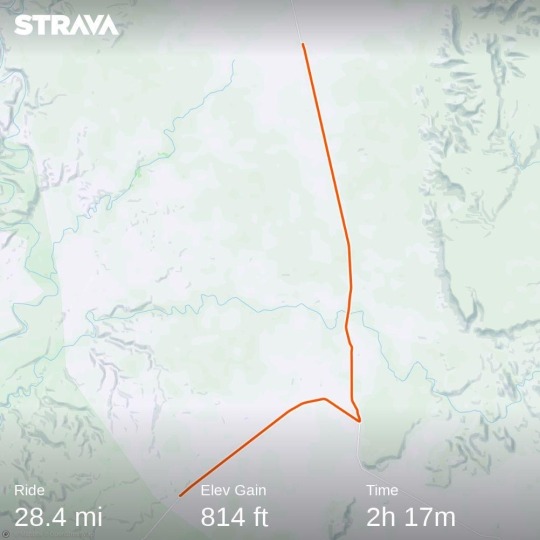
Fish River Canyon.
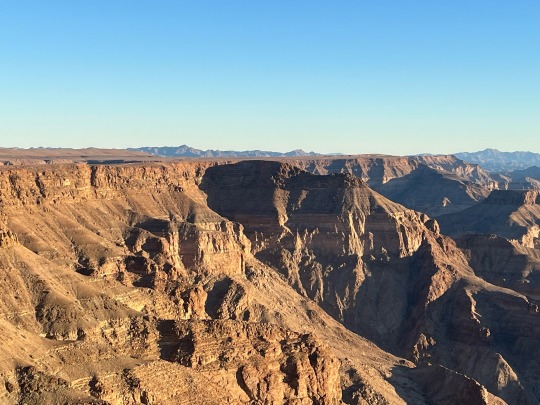

1 note
·
View note
Text
Afternoon swims in the @zannierhotels Game Reserve 😍 Tag someone you’d swim here with!
📍 Omaanda by #zannierhotels
This boutique lodge which has 10 individual Owambo-style thatch and clay huts is set in the heart of the Zannier Reserve with a 22,000-acre wildlife conservancy located half an hour from Windhoek, the Namibian capital city. Through their partnership with the N/a’an ku Foundation you can experience a wide variety of wildlife ranging from lions 🦁 to rhinos 🦏, elephants 🐘 or giraffes 🦒 Watch our stories to see more of this stunning property. 🙌🏼 www.kim.tours | [email protected]
1 note
·
View note
Text
Giraffes and Burchells Zebras (Misc)
Giraffes and Burchells Zebras (Misc)
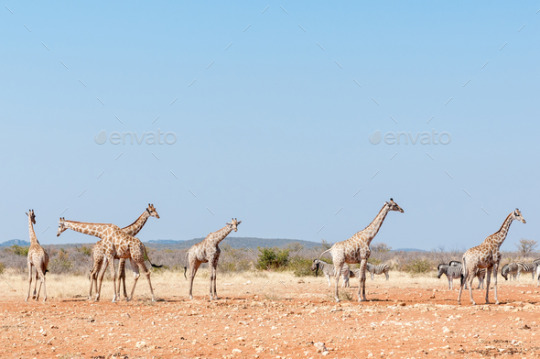
Purchase $5.00
Six giraffes and a herd of Burchells Zebras at the Rateldraf waterhole in North-Western Namibia.
Purchase $5.00
View On WordPress
#africa#african#animal#animalscape#browser#Burchells Zebra#Equus quagga burchellii#etosha#Giraffa camelopardalis angolensis#herbivore#landscape#mammal#namibia#Namibian giraffe#nature#profile#Rateldraf#scenic#sunlight#sunny#tourism#travel#wildlife#winter#zebra
0 notes
Text
Opinion: Protect the Okavango River Basin from corporate drilling
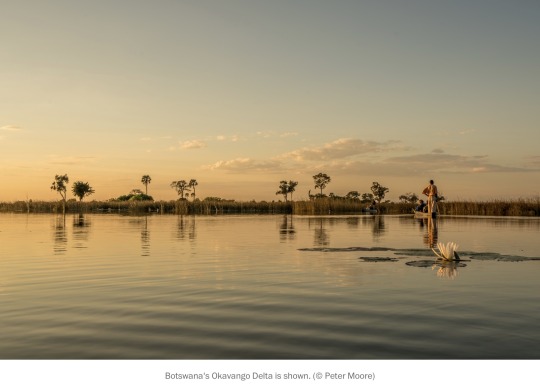
Botswana's Okavango Delta is shown. (© Peter Moore)
Opinion by Prince Harry and Reinhold Mangundu
Today at 2:46 p.m. EDT
Prince Harry, the Duke of Sussex, is co-founder of the nonprofit Archewell Foundation and is president of African Parks, a nongovernmental organization. Reinhold Mangundu is a Namibian environmental activist, conservationist and poet.
The Okavango watershed is a natural beating heart that has nourished humans and wildlife in Southern Africa for generations — and it’s at risk.
The rejuvenating waters of this complex and beautiful ecosystem — so vast it’s visible from space — ebb and flow from the highlands of Angola to the Okavango River in Namibia’s Kavango region, down to the protected Okavango Delta in Botswana.
The Okavango is a force of life, providing the main source of water for nearly 1 million Indigenous and local people and some of the planet’s most majestic wildlife, including critically endangered species. Though drought-ridden for much of the year, the region averages 2.5 trillion gallons of water flow during flooding season.
But there is an imminent threat on the horizon: corporate oil drilling.
The Okavango River Basin is under siege by ReconAfrica, a Canadian oil and gas company that has been granted licenses for exploratory drilling in an area of Namibia and Botswana larger than some European countries. We believe this would pillage the ecosystem for potential profit. Some things in life are best left undisturbed to carry out their purpose as a natural benefit. This is one of them.
We have both found sanctuary and inspiration in the Okavango, and the environmental effects of drilling are a critical concern. A recent pipeline leak off the coast of Southern California pumped more than 140,000 gallons of oil into the Pacific. In July, an oil company lit the ocean on fire in the Gulf of Mexico.
There is no way to repair the damage from these kinds of mistakes. Drilling is an outdated gamble that reaps disastrous consequences for many, and incredible riches for a powerful few. It represents a continued investment in fossil fuels instead of renewable energies.
ReconAfrica said last year that it anticipates discovering up to 32 billion barrels of oil in the Okavango. Some estimates suggest a total closer to 120 billion barrels — as if this were a good thing.
Many civil society organizations, geologists and conservationists have criticized ReconAfrica’s plans, questioning whether its environmental impact assessments sufficiently analyze the effect on local wells and aquifers, the fragile watershed and broader ecosystem.
Concern is also growing among local community members that the company’s vision of economic growth and long-term responsible resource development will fail to materialize. History is replete with examples of mega-profit projects that don’t benefit Indigenous and local people, such as the ongoing oil spills in the Niger Delta.
Hundreds of thousands of farmers and fishers depend on clean water flowing down to the Okavango Delta. In other projects, extractive development has used vast quantities of water and can leave toxic pollutants in its wake. ReconAfrica’s materials indicate it may drill for 25 years, and because the region’s waters eventually drain into the Kalahari Desert, pollutants could accumulate.
The risk of drilling will always outweigh the perceived reward. In a region already facing the abuse of exploitation, poaching and fires, the risk is even higher. Knowing the above, why would you be drilling for oil in such a place?
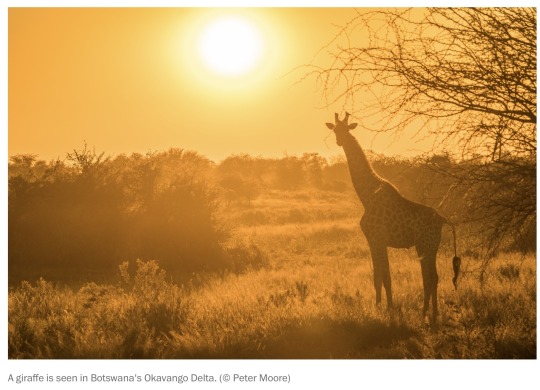
A giraffe is seen in Botswana's Okavango Delta. (© Peter Moore)
Further, the world is slowly beginning to adapt to greener energies and the power of nature-based solutions. The ecological, moral and economic imperatives to protect our natural resources eclipse the financial incentives of drilling.
Over the summer, the United Nations’ panels on climate change and biodiversity released a joint warning about the human-driven twin crises of climate change and biodiversity decline. These organizations are made up of internationally renowned scientists, researchers and other experts.
With their warning in mind, the world must take swift action to transition away from fossil fuels and toward clean, green and renewable energies.
So this is a moment to ask: How will we define, or redefine, progress?
Is it by threatening entire communities with potential pollution of their farms and broader landscape?
Is it by repelling the tourists who travel from around the globe to see a UNESCO World Heritage Site and Key Biodiversity Area, an irreplaceable place of importance to the planet’s overall health and biodiversity?
Is it by investing in fossil fuels that inhibit clean-energy innovation — all for oil that has yet to be found?
We think not.
To protect the Okavango River Basin, we call on the world to stand in solidarity with us, our allies and local communities in advocating a full moratorium on oil and gas development in the region. We also encourage investors to note who profits — notably, ReconAfrica and its partners — and who is at risk from likely environmental destruction.
This region is far more valuable in its natural state than any oil and gas reserves buried beneath it. Fortunately, this type of effort has succeeded before. With support from principled leadership, Costa Rica was one of the first countries to announce a moratorium on oil exploration — and has extended it to 2050.
Botswana and Namibia have shown interest in becoming the renewable energy hub of Africa with a commitment to a visionary solar project with the United States via USAID’s Power Africa. We applaud this commitment, which illustrates a better way forward.
Now, the choice is simple: Either we honor our natural and life-sustaining ecosystems, preserving them for generations to come, or we exploit them on a path to permanent destruction.
Will you stand with us?
https://www.washingtonpost.com/opinions/2021/10/14/prince-harry-africa-okavango-basin-drilling-moratorium/
30 notes
·
View notes
Text
Scientists Report First Instances of Dwarf Giraffes
https://sciencespies.com/news/scientists-report-first-instances-of-dwarf-giraffes/
Scientists Report First Instances of Dwarf Giraffes
In 2015, a team of conservation biologists were conducting regular surveys in Uganda’s Murchison Falls National Park when they came across an adult Nubian giraffe that didn’t quite fit a typical giraffe’s attributes. It had the characteristically long neck of a giraffe paired with short, stocky legs—instead of long, lanky legs ones, reports Annie Roth for the New York Times.
The giraffe, named Gimli, only reached a height of 9 feet, 4 inches tall—several feet shorter than the average adult, which grows to about 16 feet. The team was in “disbelief,” Michael Brown, a conservation scientist with the Giraffe Conservation Foundation and the Smithsonian Conservation Biology Institute, tells the Times.
Three years after this puzzling observation, scientists spotted an 8.5-foot-tall, Angolan giraffe on a private farm in Namibia. The team named him Nigel, reports the Times.
Using photogrammetry, a measurement technique that uses a laser to measure distances, the scientists found that Gimli and Nigel had shorter metacarpals and radial measurements, which are the bones below and above their knees respectively, reports Rachael Funnell for IFLScience.
Based on their measurements, the team came to the conclusion that dwarfism was the most likely explanation for their different body sizes and proportions.
“While the Namibian farmer had spotted Nigel regularly over the years, it was only after our observations that he realized that Nigel was not a juvenile but a fully grown male giraffe,” co-author Emma Wells, a researcher for the Giraffe Conservation Foundation. “It is mainly in comparison to other giraffe that his difference in stature becomes obvious.”
youtube
According to a statement from the Giraffe Conservation Foundation, this is the first time that dwarfism has been documented in captive or wild giraffes. The scientists published their findings in December in the journal BMC Research Notes.
Dwarfism, also known as skeletal dysplasia, is a genetic condition that can affect bone and cartilage growth, which can lead to disproportionately sized arms, legs, head or abdomen, according to the Cleveland Clinic. The condition has been well-documented in people, and it’s also known to occur in dogs, cows and pigs, reports the Times.
“Instances of wild animals with these types of skeletal dysplasias are extraordinarily rare,” Brown says in the statement. “It’s another interesting wrinkle in the unique story of giraffe in these diverse ecosystems.”
How these two giraffes ended up with dwarfism is still hazy. Random mutations in the genetic code can cause dwarfism, but it can also be linked to low genetic diversity or inbreeding, reports the Times.
“It’s worth noting that the Murchison Falls National Park giraffe population in Uganda experienced a significant population bottleneck in the late 1980s as a result of civil unrest and poaching,” Brown tells IFLScience. “The population has rebounded remarkably since then with current estimates of over 1,500 [giraffes], although it’s unclear if there are any lingering impacts of the earlier population bottleneck.”
The scientists plan to monitor Gimli and Nigel over the course of their lives to see if their dwarfism affects their behavior and social statuses, according to the statement.
#News
104 notes
·
View notes
Video
youtube
Okutala Etosha Lodge is a private lodge situated on a breath-taking piece of Namibian land, covering 24,000 hectares. We focus on releasing wild animals within their natural habitat. It is here where you will find the Giraffe - looking down on you while cooling off in our sparkling pool, or you might have to share your breakfast with our family of Mongoose. Enjoy our cuisine on the open deck, while watching a large variety of wild animals come and drink at the waterhole.
------------------------------------------
Die Okutala Etosha Lodge ist eine private Lodge auf einem atemberaubenden Gelände mit einer Fläche von 24.000 Hektar. Der Fokus liegt darauf, wilde Tiere in ihren natürlichen Lebensraum zu halten. Hier findet man auch Giraffen, die beim Abkühlen im Pool auf einen herabblicken, oder man muss das Frühstück mit der Mangustenfamilie teilen. Die Mahlzeiten werden auf dem Oberdeck serviert - während dessen lassen sich eine Vielzahl wilder Tiere beobachten, die unten am Wasserloch trinken.
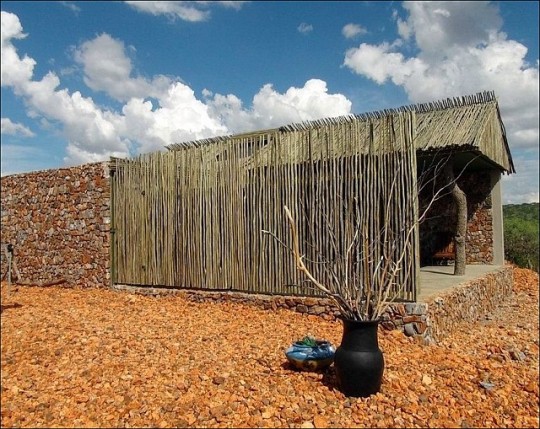



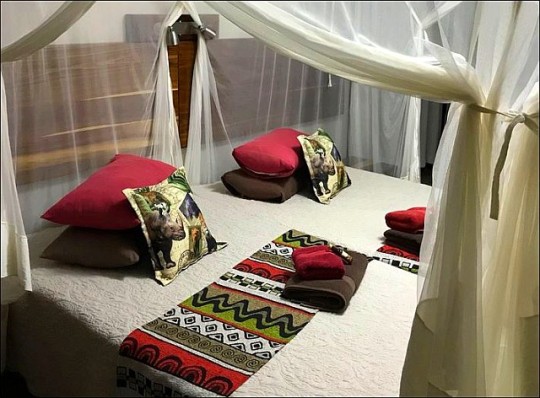

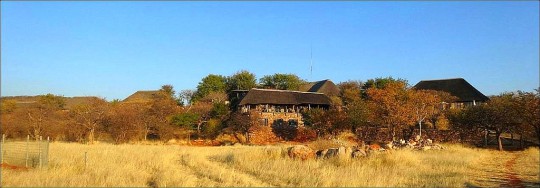

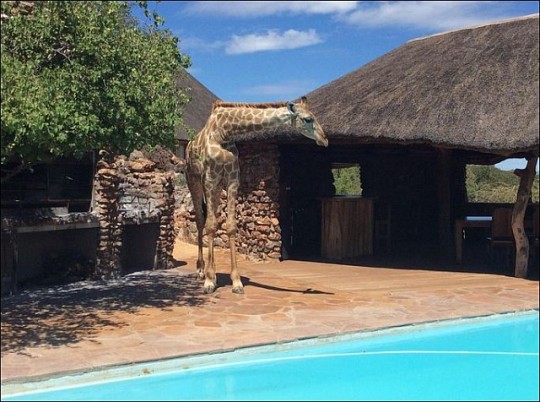


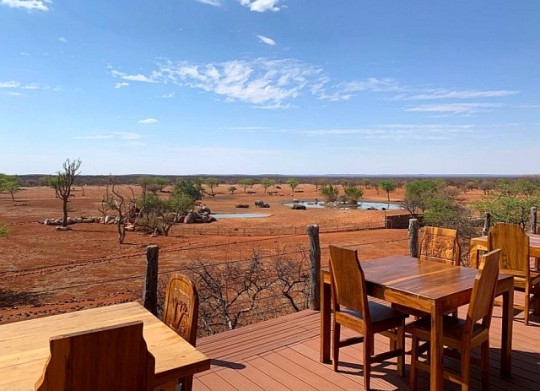

3 notes
·
View notes
Photo
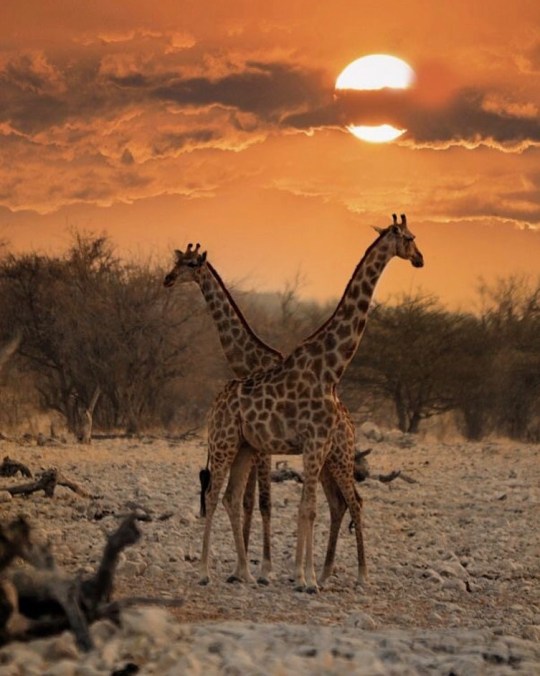
Namibian Giraffes at sunset 📸ABulimia159 #namibia #safari #animallovers #animals — view on Instagram https://ift.tt/3fPb9yI
9 notes
·
View notes
Text
Justice for Nature!
Written in collaboration with Fatemeh Yazdani (find her here)
youtube
Shocking, breathtaking and traumatic. These were our first impression of watching Safari; a semi-staged documentary directed by Ulrich Seidl about a Namibian hunting lodge which provides the experience of hunting for wealthy tourists. The camera follows an Austrian family killing endangered animals such as zebras and giraffes just for entertainment. The film has been conducted based on observation and interview so that the camera follows the hunters-tourists in the entire process of haunting; going to the zone, looking for the prey, stalking, adjusting the rifle, and shooting. Furthermore, it contains several interviews with hunters-tourists and the owners of the lodge in order to elaborate on their points of view about the hunting industry as a way of enjoyment.
The film is started with a long shot of Namibia nature while a hunter-tourist standing in the center of the shot playing trumpet; which implicitly tell us the initiation of an unequal battle; culture vs. nature. Indeed, Seidl places human agents in the focal point of the symmetrical shots in order to show how the domination of culture over nature within the human-centric anthology leads to the disaster.
The film includes some provocative and brutal scenes including taking trophy photograph with the carcass of the prey and decorating it for the sake of the pride. The most irritating scenes were filmed in the lodge when the black employees should skin and dismember the dead body of the animals.
The servants, who do everything else for the white hunters after the rifle goes off, from skinning to the taxidermy, are not included in the human agency at the center of the world. They are even excluded from having a voice in the film; in his damnation of how the Austrian tourists appearing his film think, Seidl interviewed every one of them, but only let his camera gaze at the black workers, watching as they silence work on the animal bodies, or even filming them chew on the leftover meat they are given. Maybe Seidl wanted to show us how they are not allowed much say in this arrangement, to cement that it is still mainly white agency impacting the planet and other humans living on it, but it would have been interesting to listen to what the Namibians have to say about their position in this hierarchy.

Therefore, we see Safari constructing a reality that is best understood at the intersection of two principle concepts; Anthropocene and Colonialism. The movie is structured exposing two hierarchical relationships; the supremacy of the human being over non-human agents and also the superiority of the White over Non-White, specifically black local people of Namibia.
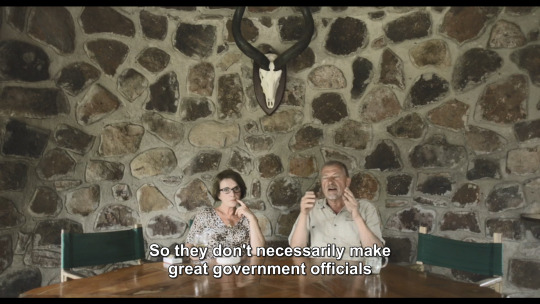
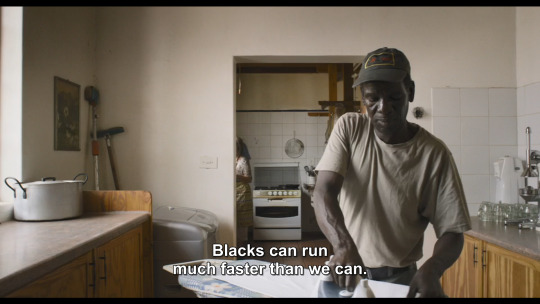
According to the Anthropocene as a geological epoch, human agency has been placed in the center of understanding and interpreting the world. The story we see of the hunting lodge is just one intensified example of how putting that human agency in the center has pushed life on Earth out of its metaphorical orbit: the story of tourists who traveled all the way to Namibia to add to the endangerment of whole animal species, not out of necessity, survival, or even utility, but just to satisfy the desire to take life, to feel the thrill of causing destruction with a click. With human agency placed in the center of the world, everything else is collateral not only to our needs but also to our whims, which can later be justified as ‘helping the elderly animals’ or ‘keeping them from overbreeding’.
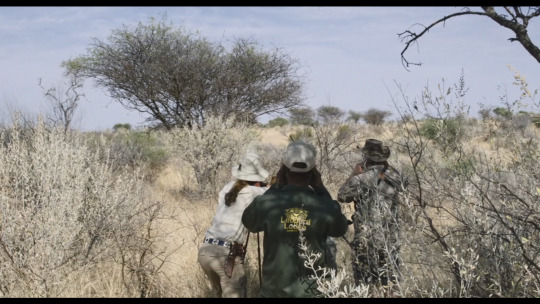
#Visual Anthropology#anthropology#social anthropology#anthropocene#colonialism#safari#hunting#ulrich seidl#namibia#austria#nature#endangered animals
1 note
·
View note
Photo
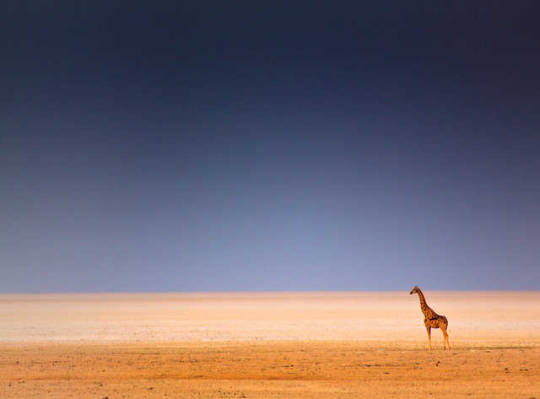
Namibian Giraffe by Riccardo Castellan on 500px
4 notes
·
View notes
Photo
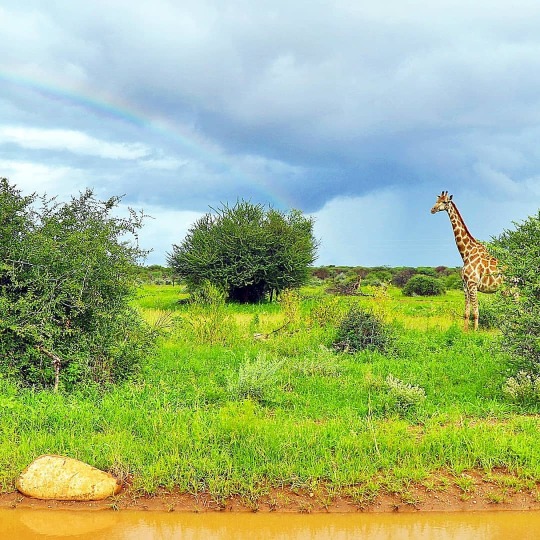
Wet season is an unusual time in Namibia. Bright green vegetation erupts from the dry desert, lightning storms illuminate the sky, thorn trees thicken and obscure views and soupy pools of muddy water form across all the roads. The animals appreciate the water while it lasts. @erindinamibia @africanimals @grandiosegiraffes @deinnamibia #giraffe #tall #tallest #tower #height #high #green #clouds #thunder #storm #stormy #stormclouds #africa #african #thunderstorm #namibian #namibia #erindi #erongo #omaruru #wild #wildlife #wildlifephotography #wetseason #safari #selfdriving #chrismilliganphoto https://www.instagram.com/p/CFIGqiugFoY/?igshid=1hzllayjnmuyv
#giraffe#tall#tallest#tower#height#high#green#clouds#thunder#storm#stormy#stormclouds#africa#african#thunderstorm#namibian#namibia#erindi#erongo#omaruru#wild#wildlife#wildlifephotography#wetseason#safari#selfdriving#chrismilliganphoto
0 notes
Text
Dwarfism discovered in the world's tallest animal. Giraffes stunted by a bone growth disorder can be half the average 16 ft height.
Dwarfism discovered in the world’s tallest animal. Giraffes stunted by a bone growth disorder can be half the average 16 ft height.
Summary List Placement
Two dwarf giraffe have been discovered for the first time in Africa by scientists from the Giraffe Conservation Foundation (GCF).
One giraffe was found in Murchison Falls National Park in Uganda in 2015 and the other on a private farm in central Namibia in 2018.
The giraffe seen in Uganda has been named ‘Gimli’ after the Lord of the Rings character, while the Namibian…
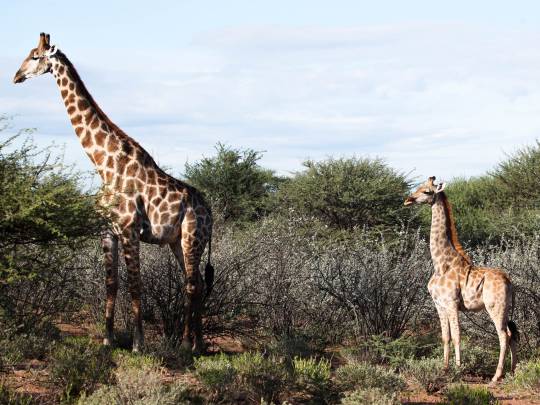
View On WordPress
0 notes
Text
Wow, scientists discovered dwarf giraffes
The wild teems with the unknown.
Researchers have recognized two dwarf giraffes, the primary such animals recognized to science. Throughout routine surveys of endangered, troubled giraffe populations by the conservation group Giraffe Conservation Basis, biologists discovered the 2 curious ungulates, one in Namibia and the opposite in Uganda.
In analysis just lately revealed within the journal BMC Research Notes, biologists conclude the giraffes have skeletal or cartilaginous issues, a uncommon prevalence in most wild, free-ranging animal populations. That they had significantly quick legs, and one had a shorter than common neck.
The peak of a typical giraffe is round 16 toes. However the giraffe present in central Namibia measured nine feet, four inches tall. That is fairly quick (for a giraffe). The giraffe, referred to as Nigel, was a mature grownup animal. The opposite giraffe, in Uganda, who was measured as a sub-adult (that means an unbiased and maturing animal), reached about eight and a half toes tall.
“Cases of untamed animals with all these skeletal dysplasias are terribly uncommon,” Michael Brown, a conservation biologist and lead creator of the analysis mentioned in a press release. “It’s one other fascinating wrinkle within the distinctive story of giraffe in these numerous ecosystems.”
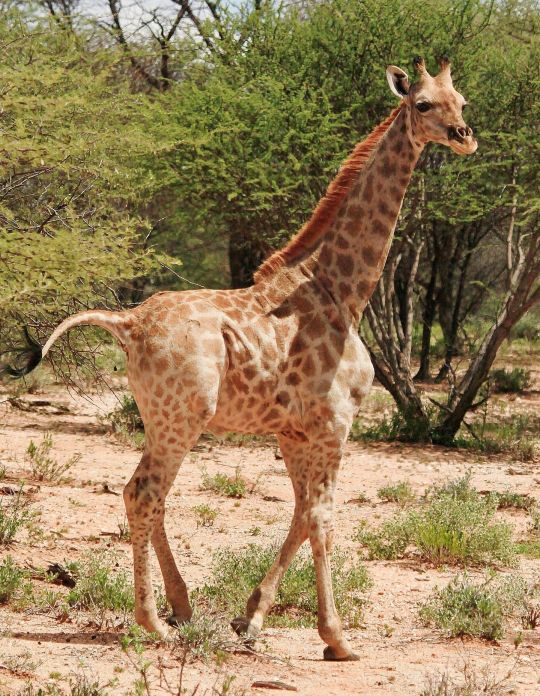
The dwarf giraffe in Namibia in 2018.
Picture: Emma Wells / GCF
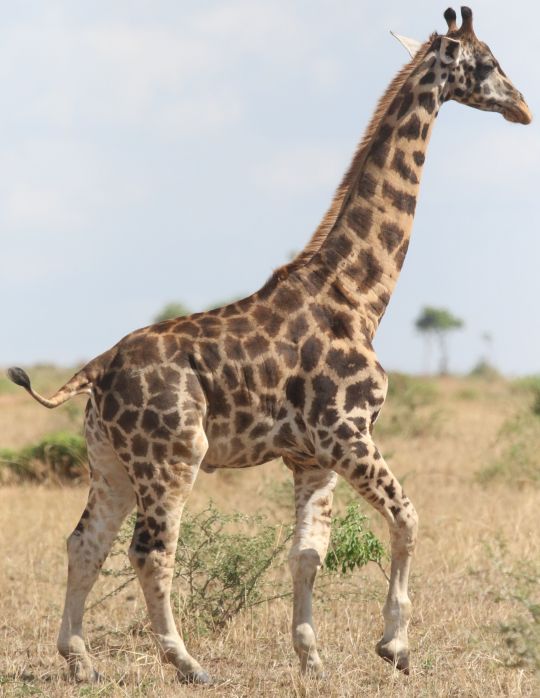
The dwarf giraffe in Uganda in 2017.
Picture: Michael Brown / GCF
Each giraffes apparently succeeded with diminished top for years, rising to both an grownup or a maturing animal nearing maturity. Nonetheless, biologists have not noticed the Ugandan giraffe since 2017 and the Namibian giraffe since July 2020. Certainly, their shorter legs could have hindered motion, making them extra inclined to quick predators, the researchers conclude.
Total, giraffes are in a nasty spot. Right this moment, some 111,000 stay within the wild, however they’ve misplaced some 36 to 40 percent of their population over the previous couple of a long time.
“Giraffe are present process a silent extinction in Africa,” Julian Fennessy, director of the Giraffe Conservation Basis, mentioned in a press release. “The truth that that is the primary description of dwarf giraffe is simply one other instance of how little we find out about these charismatic animals.”
!function(f,b,e,v,n,t,s){if(f.fbq)return;n=f.fbq=function(){n.callMethod? n.callMethod.apply(n,arguments):n.queue.push(arguments)};if(!f._fbq)f._fbq=n; n.push=n;n.loaded=!0;n.version='2.0';n.queue=[];t=b.createElement(e);t.async=!0; t.src=v;s=b.getElementsByTagName(e)[0];s.parentNode.insertBefore(t,s)}(window, document,'script','https://connect.facebook.net/en_US/fbevents.js');
fbq('init', '1453039084979896'); fbq('init', '156932198698582'); if (window._geo == 'GB') { fbq('init', '322220058389212'); }
window.addEventListener('DOMContentLoaded', function() { mashKit.gdpr.trackerFactory(function() { fbq('track', "PageView"); }).render(); });
Source link
from Diaspora9ja https://diaspora9ja.com/wow-scientists-discovered-dwarf-giraffes/?utm_source=rss&utm_medium=rss&utm_campaign=wow-scientists-discovered-dwarf-giraffes
0 notes